Get in touch
(978) 537-1661
Blog
Manor on The Hill updates & insights
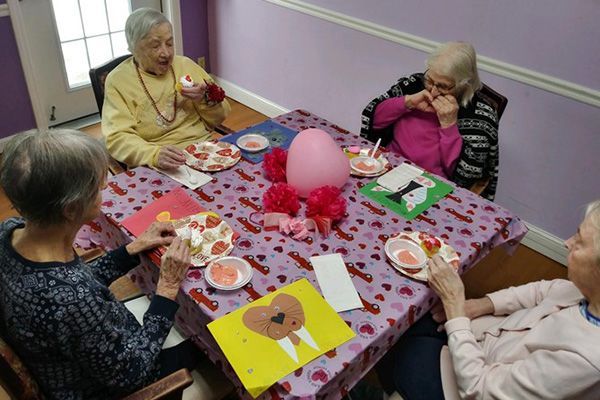
April 1, 2021
They say “It takes a village to raise a child”; Knowledge, wisdom, and unconditional love by seniors have a lasting effect on children. Children can also bring happiness and smiles to seniors. We can reminisce about the past when extended families lived close together on the same street or in the same town and interacted frequently. Manor on the Hill (pre-pandemic) had a “Adopt a Grandparent Program” where preschool children came every month to do activities with the residents. This was the most popular activity for both generations. Meaningful activities between seniors and children can be fun and educational. Here are examples of things that the seniors can talk about bringing back nostalgic memories and educating the children at the same time: Tin of Spam: Most children will have no idea what it is however seniors will have memories of tinned meat that could be transported and stored without refrigeration. Rotary phone: Dialing numbers one-by-one, one mistake or busy line and had to start all over again Payphones and a dime in their penny-loafers to call home. Many may have used their dime for a treat at the corner store. Printed references like the phone book, TV Guide and an Encyclopedia set Gramophone records; Side A & B with a handful of songs Silent movies & news reals Rationing during the wars Games they played

April 15, 2019
Sundowning is a neurological phenomenon associated with increased confusion and restlessness most commonly associated with Alzheimer’s disease, but also found in those with other forms of dementia. The term “sundowning” was coined due to the timing of the patient’s confusion as it typically occurs late in the day or early evening as the sun is setting. The symptoms may include increased confusion, anxiety, aggression, agitation and ignoring directions. Sundowning seems to occur more frequently during the middle stages of Alzheimer’s disease and mixed dementia and subsides with the progression of a patient’s dementia. Here are some useful tips to deal with sundowning behavior: Close blinds and drapes so that the decreasing light outdoors is not easily seen. Brighten the interior environment with increased lighting being careful to keep the room free from shadows. Dementia sufferers may mistake a shadow for a hole to avoid increasing the risk of falls as they move away to avoid what they believe is a danger. Create a calm environment. Turn off the TV and put soothing music on. Be sure the music is era appropriate; Sinatra not Madonna. Limit day time napping. While the cause of sundowning is not completely understood, it is known to be a disturbance of the internal clock. Keeping to a set sleep schedule with limited napping is known to help. Be patient and distract with an enjoyable activity. View a favorite photo album, brush hair, water indoor plants. Find a calm, soothing activity the senior enjoys and be patient sharing the activity with them. Here at Manor on the Hill, we incorporate these tips into our evenings to help our Residents who suffer from sundowning helping them get to their bedtime routine and sleep.
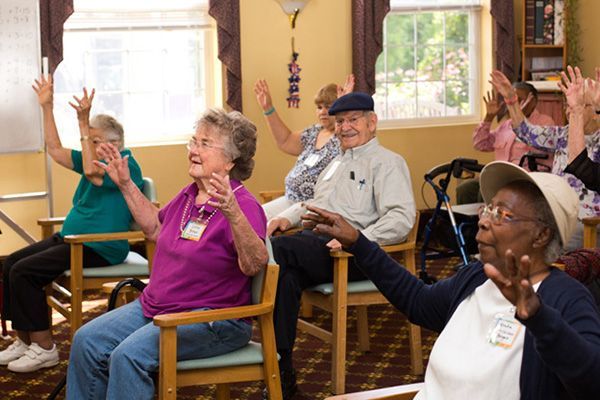
March 21, 2019
Risk factors have been identified to assess your risk of developing Alzheimer’s. Some are uncontrollable, such as age, while others can be influenced by your choices. Uncontrollable Factors: Age – is the greatest known factor for Alzheimer’s. One out of three people who are 85 or older have the disease. Family History – is another strong risk factor. Those who have a parent or sibling with the disease is at a higher risk of contracting Alzheimer’s. Genetics – Science has identified several risk genes and deterministic genes that influence the odds of developing Alzheimer’s. Risk genes increase the likelihood of developing the disease but do not guarantee that the person with the risk gene will indeed develop the disease. The gene with the strongest link to the disease is apolipoprotein E-e4 (APOE-e4); those who have this gene have a one in four chance of developing Alzheimer’s. A deterministic gene is a gene that directly causes the disease. Those who have a deterministic gene will develop Alzheimer’s. Science has so far found three deterministic genes that lead to Alzheimer’s – amyloid precursor protein (APP), presenilin-1 (PS-1) and presenilin-2 (PS-2). Controllable Factors: Recent research has found links of risk factors we can control through our general lifestyle and wellness choices. Head Trauma – research has shown a strong link between serious head injuries and further risk of Alzheimer’s. Healthy Heart – there is growing evidence of a link between heart health and brain health. Those who suffer from high blood pressure, heart disease, diabetes and high cholesterol have a higher risk of developing Alzheimer’s. Ethnicity – because Latinos and African Americans have higher rates of vascular disease (see above), they may also be at a higher risk for Alzheimer’s. Healthy Aging – overall healthy aging may also keep your brain fit. Keep your weight within recommended guidelines, avoid tobacco and excessive alcohol use, be socially involved and exercise your brain and your body.
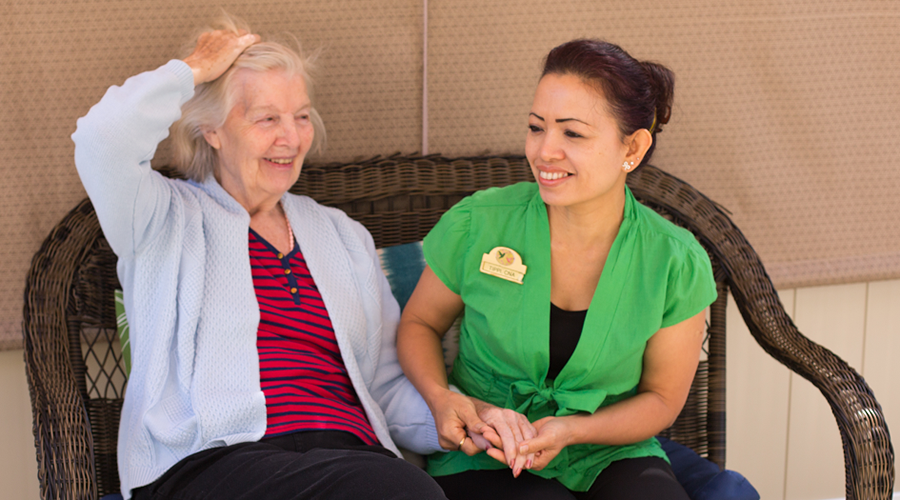
March 15, 2019
The other day as I was walking through our Memory Care Lane, the memory care wing at our Assisted Living Community in Leominster, MA, I was able to observe the quality care and compassion one of our CNAs was providing one of the seniors living with us. The Resident, whom I will call Nancy (not her real name due to HIPPA) was being attended to by one of our long-tenured aides (whom will refer to as Lisa) who had specialized training in Alzheimer’s Care. Lisa’s approach to Nancy demonstrated several key practices in communicating with a senior citizen with Alzheimer’s or Dementia which I thought would be useful to share. Lisa had approached Nancy from the front, introducing herself, probably for the thousandth time. As Nancy was seated, Lisa got down on her level maintaining eye contact the entire time. Lisa placed a hand on Nancy’s forearm to give her physical comfort. Keep in mind that if the senior is irritated by touch, to avoid this, but be sure to practice the other approach keys – approach from the front, introduce yourself by name, be on the same level and maintain eye contact. Lisa called Nancy by name to help orient her and to gain her attention and focus. Lisa used a lower pitch as it is more calming. She spoke slowly asking Nancy one question at a time in short sentences with simple words so as not to overwhelm Nancy. When Nancy didn’t respond immediately, she patiently waited as Alzheimer suffers often need more time to process. When Nancy didn’t respond, Lisa repeated the question using the same words rather than changing words which can lead to more confusion and agitation. Rather than asking Lisa questions, she turned the question into an answer, providing a solution. As it was close to lunch time, rather than saying “Are you hungry?”, Lisa said “The Dining Room is around the corner. Let me take you there.” To get Nancy ready for the walk to the Dining Room, Lisa placed Nancy’s hand on her walker, providing a visual cue on what Lisa would like her to do. Nancy understood this cue and stood up, allowing Lisa to escort her to her meal. During this entire encounter, Lisa avoided quizzing her, peppering her with questions or asking her questions such as, “Do you remember what you wanted?”. Asking a person with dementia to remember only adds to their frustration. Throughout Lisa presented an easygoing manner with a gentle, kind tone of voice supported by friendly facial expressions. Most importantly, Lisa treated Nancy with dignity and respect. I was so proud of Lisa that I gave her a Manor Moment, a program of recognition for these numerous special moments at Manor on the Hill. Please look for more useful information each week. Thanks for reading.
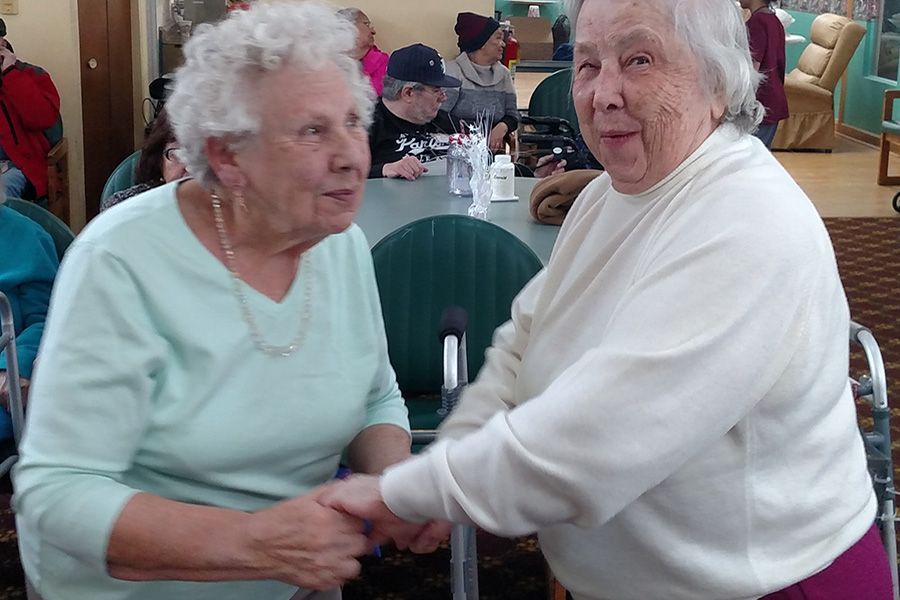
February 17, 2019
We often have family visit us here at Manor on the Hill and can see immediately in their eyes the stress of caring for an elderly parent. Moving Mom or Dad from their long-time home can be unsettling, however, making that move is often in their best interest. 30 days after moving in, we see Residents gaining weight since they are being served three nutritious meals a day and their mood improves as they socialize with others in their new home. Other than the stress caring for a senior presents, what are some other signs it may be time to consider Assisted Living? Housework is being neglected The senior doesn’t bathe regularly, often as they worried about safety in the tub or shower Laundry isn’t being done and the same clothes are being worn day-after-day Bills aren’t being paid timely Medical care is needed more frequently, often with hospitalization Your loved one feels isolated and bored, often leading to depression Difficulty managing their medication Increased falls and other accidents Memory loss and forgotten appointments Increased aggressive behavior The generation your Mom and Dad belongs too often views an Assisted Living Community with their image of a Nursing Home from the 60s or 70s. This isn’t accurate as Nursing Homes are very different from that image and Assisted Living Communities are a relatively new concept. Assisted Living should be thought of as being comprised of three parts – real estate, hospitality and care. The real estate is the apartment they rent, as well as the enjoyment of the communal living spaces such as the dining room, library, activity room, community kitchen and grounds. The hospitality consists of dining, activities, entertainment and trips to area stores, restaurants and cultural attractions. And the care component is assistance with the six Activities of Daily Living (ADLs) – bathing, grooming, dressing, toileting, mobility and eating. After a family makes the decision to move Mom or Dad to Manor on the Hill, we often hear within the first month, “I wish I had done this sooner”. Call for a visit to see how we can help you and your senior parent.
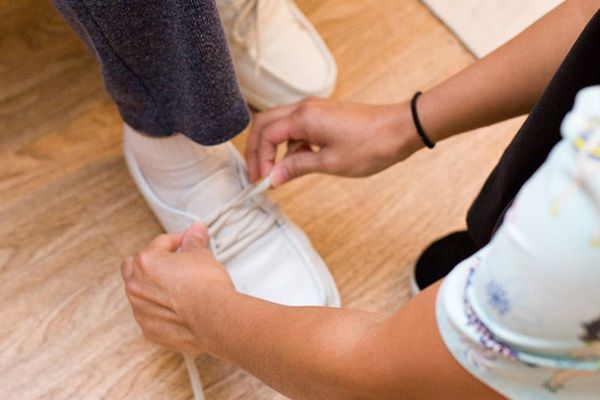
January 29, 2019
"Proper footwear is an important defense against the risk of falling" One major consequence of growing older is the increased likelihood of falling. One of four people over age 65 falls each year. Falling once doubles your chance of falling again. Understanding the causes and implementing easy interventions, in conjunction with your medical team and family, can reduce or eliminate the risk of falling. Doing so important for the elderly as the impact of falling is significant: One of five falls will cause a serious injury 8 million older people are treated in an emergency room annually for injuries related to falls. More than 800,000 are hospitalized each year after a fall At least 300,000 of the hospitalizations are for fractured hips The direct medical costs for fall injuries are $31 billion annually. Because of the impact on the quality of life of seniors after a fall, and the financial costs, a lot of research has been done to identify risk factors and what can be done to prevent falls. Risk factors include: Lower body weakness Use of medicines, particularly sedatives, tranquilizers and antidepressants Vision issues Balance difficulties Vitamin D deficiency Home hazards Foot pain or improper footwear While all falls cannot be prevented, simple steps can go a long way to minimize the chances of falling. These include: Visit your doctor. Discuss with him or her a list of your medications, both prescribed and over-the-counter. Your doctor can review your medications for side effects and interactions that may increase your chance of falling. Also tell your doctor about how comfortable you are when you walk – do you grab items such as chairs to steady yourself; do you feel dizzy when standing or walking; do you suffer joint pain or a shortness of breath; do you have numbness in your lower extremities. These will help your physician evaluate your risk for falling. Exercise. Do exercises that make your legs stronger and your balance better. Exercise need not be strenuous, just done on a consistent basis, in order for you to see improvement. Tai chi is a good exercise for seniors. Have your Eyes Checked. Do this at least once a year. Update your eyewear as needed. Consider ditching those bifocals and have dedicated glasses for reading and another pair for distance. Wear the Right Shoe. Wear properly fitting, sturdy shows with nonskid soles. If you wear slippers around the house, these too should have nonskid soles and should not be loose but snug. Look around your home. Remove throw rugs and clutter. Move coffee tables, magazine stands and plants from high traffic areas. Make sure handrails, floorboards and steps are secure. Add a second handrail on the stairs so there is one on both sides for your use. Use non-skid floor wax. Store items you use a lot, especially in the kitchen, at an easy to reach level. Add grab bars in the bathroom and grab handles at the front door. Keep your tub free of soap build up and install no-slip strips in the bath or shower. Light it up. Keep your home brightly lit to avoid tripping on hard-to-see items. Turn on the light before going up or down stairs or through a room. Trade out the light switch for a glow-in-the-dark switch. Place nightlights in hallways, bedrooms, bathrooms and stairways. Keep lighting uniform in each room and add lighting to dark areas. Use a cane or walker. And if you do, use it all the time, even for a short walk across a room. At Manor on the Hill, we conduct a fall risk assessment regularly with our Residents and partner with health providers to implement these suggestions, as well as, to engage in our Residents in Physical or Occupational Therapy as needed. A little planning can help prevent falls and keep you from becoming a statistic.

January 21, 2019
Memory loss that disrupts daily life may be a symptom of Alzheimer’s or other dementia. Alzheimer’s is a brain disease that causes a slow decline in memory, thinking and reasoning skills. There are 10 warning signs and symptoms. If you notice any of them, don’t ignore them. Schedule an appointment with your doctor. 1. Memory loss that disrupts daily life One of the most common signs of Alzheimer’s disease, especially in the early stage, is forgetting recently learned information. Others include forgetting important dates or events, asking for the same information over and over, and increasingly needing to rely on memory aids (e.g., reminder notes or electronic devices) or family members for things they used to handle on their own. What’s a typical age-related change? Sometimes forgetting names or appointments, but remembering them later. 2. Challenges in planning or solving problems Some people may experience changes in their ability to develop and follow a plan or work with numbers. They may have trouble following a familiar recipe or keeping track of monthly bills. They may have difficulty concentrating and take much longer to do things than they did before. What’s a typical age-related change? Making occasional errors when balancing a checkbook. 3. Difficulty completing familiar tasks at home, at work or at leisure People with Alzheimer’s often find it hard to complete daily tasks. Sometimes, people may have trouble driving to a familiar location, managing a budget at work or remembering the rules of a favorite game. What’s a typical age-related change? Occasionally needing help to use the settings on a microwave or to record a television show. 4. Confusion with time or place People with Alzheimer’s can lose track of dates, seasons and the passage of time. They may have trouble understanding something if it is not happening immediately. Sometimes they may forget where they are or how they got there. What’s a typical age-related change? Getting confused about the day of the week but figuring it out later. 5. Trouble understanding visual images and spatial relationships For some people, having vision problems is a sign of Alzheimer’s. They may have difficulty reading, judging distance and determining color or contrast, which may cause problems with driving. What’s a typical age-related change? Vision changes related to cataracts. 6. New problems with words in speaking or writing People with Alzheimer’s may have trouble following or joining a conversation. They may stop in the middle of a conversation and have no idea how to continue or they may repeat themselves. They may struggle with vocabulary, have problems finding the right word or call things by the wrong name (e.g., calling a “watch” a “hand-clock”). What’s a typical age-related change? Sometimes having trouble finding the right word. 7. Misplacing things and losing the ability to retrace steps A person with Alzheimer’s disease may put things in unusual places. They may lose things and be unable to go back over their steps to find them again. Sometimes, they may accuse others of stealing. This may occur more frequently over time. What’s a typical age-related change? Misplacing things from time to time and retracing steps to find them. 8. Decreased or poor judgment People with Alzheimer’s may experience changes in judgment or decision-making. For example, they may use poor judgment when dealing with money, giving large amounts to telemarketers. They may pay less attention to grooming or keeping themselves clean. What’s a typical age-related change? Making a bad decision once in a while. 9. Withdrawal from work or social activities A person with Alzheimer’s may start to remove themselves from hobbies, social activities, work projects or sports. They may have trouble keeping up with a favorite sports team or remembering how to complete a favorite hobby. They also may avoid being social because of the changes they have experienced. What’s a typical age-related change? Sometimes feeling weary of work, family and social obligations. 10. Changes in mood and personality The mood and personalities of people with Alzheimer’s can change. They can become confused, suspicious, depressed, fearful or anxious. They may be easily upset at home, at work, with friends or in places where they are out of their comfort zone What’s a typical age-related change? Developing very specific ways of doing things and becoming irritable when a routine is disrupted. Get checked. Early detection matters. If you notice any of the 10 Warning Signs of Alzheimer’s in yourself or someone you know, don’t ignore them. Schedule an appointment with your doctor. Learn more about diagnosing Alzheimer’s Doctor’s appointment checklist (PDF) 10 warning signs checklist (PDF) 10 steps to approach memory concerns (PDF) Why get checked What is the difference between Alzheimer’s and typical age-related changes? Signs of Alzheimer’s and Dementia Poor judgment and decision-making Inability to manage a budget Losing track of the date or the season Difficulty having a conversation Misplacing things and being unable to retrace steps to find them Typical Age-Related Changes Making a bad decision once in a while Missing a monthly payment Forgetting which day it is and remembering it later Sometimes forgetting which word to use Losing things from time to time What to do if you notice these signs If you notice any of the 10 Warning Signs of Alzheimer’s in yourself or someone you know, don’t ignore them. Schedule an appointment with your doctor. With early detection, you can explore treatments that may provide some relief of symptoms and help you maintain a level of independence longer, as well as increase your chances of participating in clinical drug trials that help advance research. Learn About Treatments Learn About Clinical Trials Source: Alzheimer’s Association Reference: https://www.alz.org/alzheimers-dementia/10_signs

January 30, 2018
Published in Sentinel and Enterprise News by Peter Jasinski Leominster – Wiles celebrated her 100th birthday among family and friends Tuesday at Manor on the Hill, where she currently resides. She is now the second resident currently living in that community to reach centenarian status and, as her family explained, she remains one of the most lively people living there. As she got ready to officially complete the first century of her life, Eunice Wiles joked that she was a little surprised to be having such a milestone birthday. “It’s just another birthday for me, but they just keep piling up,” she said. Wiles’ son, Rick, said his mother was born in Brooklyn and lived most of her life in New York state. She and her late husband raised their two children in Kingston, New York, and relocated briefly to Florida before she moved to Massachusetts to be closer to her son after her husband’s death. She worked most of her career as an administrative secretary in different New York public school systems, as well as secretary to the chairman of the New York State Republican Party. “She’s always been a hard worker and she’s very devoted to whatever task is at hand. And she’s a very smart person,” Rick Wiles said. “She’s also a very dedicated friend. People she knows have always said that if she’s your friend, she’s your friend for life.” Manor on the Hill Activities Director Patrick Long said Wiles had made great strides since moving to the community in 2015, noting that she had originally been a part of their Memory Care program for Alzheimer’s and dementia residents, but no longer is. “In the years that I have worked here, I have never heard of a person who has gotten to a point where they could transition out of Memory Care,” he said. “In my opinion, that’s a very big deal.” … Click on Original Article to read full article, Leominster centenarian’s secret? ‘Stay out of trouble’, Upbeat attitude goes a long way – Just ask Eunice Wiles By Peter Jasinski, pjasinski@sentinelandenterprise.com Click for PDF version from Sentinel and Enterprise . Click for Text version from Sentinel and Enterprise .

Quick Links
© 2025
All Rights Reserved | Manor On The Hill
© 2025
All Rights Reserved | Manor On The Hill

